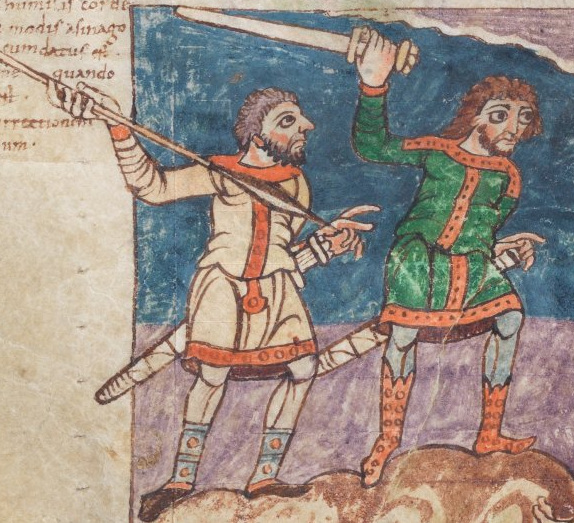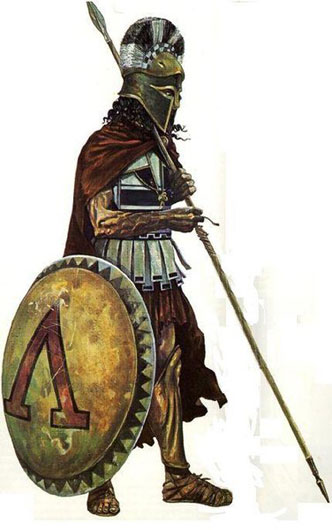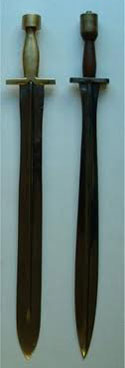Oh August 24th, the Smithsonian Magazine ran an article about a kid who, right now, is the embodiment of beginner's luck. In July, Fionntan Hughes received a metal detector for his birthday. On his and his father's first trek out with the new device, along the river Blackwater in Northern Ireland, the pair discovered a sword buried in the riverbank, about a foot deep.
/https://public-media.si-cdn.com/filer/cb/23/cb23eb85-cca2-49c7-bae5-95cdc323705d/2020_aug22_rustysword.jpg) | |
10-year-old Fionntan Hughes found the sword on his first day using a new metal detector. (Courtesy of Brian Quinn/Clonoe Gallery) |
The rusted and pitted weapons is some type of basket-hilted weapons with an ornate pommel and broken blade. The rust-covered item has yet to be turned over to researchers for a more detailed study of it, but a cursory look at the photos has lead to some speculation:
The sword’s ornate handle is its most identifiable feature, but antiques experts Mark and David Hawkins tell BBC News that the sword is difficult to identify from photographs because the rust may be exaggerating its size. But it looks like an English basket-hilted broadsword that was introduced between 1610 to 1640.
On August 25th, he Vintage news ran an article about the discovery of a bronze age sword located in Scotland. 44 year old Mariusz Stepien was going to a field with his metal detector, looking for any artifacts that the soil might have to offer. What he actually found was more than just a sword. The weapon was part of a larger collection that looks to include the sword (still in its scabbard), chariot wheel axle caps, and an entire horse harness, along with a decorative rattle pendant that would have been placed on the harness, the only one like it ever found in Scotland!
Stephien contacted the Crown Office Treasure Trove Unit, a movement office that specialized in this type of discovery. Emily Freeman, the head archaeologist with the unit who went to investigate the find, recently told the BBC, “it’s a nationally significant find.” The unit took 22 days to excavate the full discovery.
The heavily rusted and crusted over blade is going to be studied with an x-ray in order to learn more about the metalwork, detail, and any etching that might have been put into the blade.
note: the article had a full 3D scan of the dig site, and annotations of the items in the image.
On August 28th, Gizmogo ran an article talking about a viking funeral site in Norway with some unusual characteristics, not the least of which was the positioning of the weapons (specifically the sword) with the body, leading the researchers to believe the one-time warrior was left-handed.
On August 28th, Gizmogo ran an article talking about a viking funeral site in Norway with some unusual characteristics, not the least of which was the positioning of the weapons (specifically the sword) with the body, leading the researchers to believe the one-time warrior was left-handed.
Speaking about the sword in the article:
“I’m a little surprised at how heavy it was,” Astrid Kviseth, an archaeologist at Norwegian University of Science and Technology (NTNU), told Science Norway. “I don’t exactly know how heavy a sword is, but it had some heft to it. You would have had to be pretty strong to be able to swing this sword!”
About the position of the sword, it went on to add:
Normally, swords are placed on the right side of a Viking grave, which may sound strange given that right-handed people keep their sheaths on the left side of their bodies for easy access. A going theory is that the Viking afterlife, or underworld, is the “mirror image of the upper world,” Sauvage explained. The unusual placement of the sword suggests the warrior was left-handed, as this configuration best prepared him for the afterlife, according to the archaeologists.
A final note of interest, albeit not sword related, was the additional discovery of a grave in the same area that, based on the artifacts located there, was a prestigious resting place for a woman. Unique in this find was the type of remains. The weight of cremated bone in this site was consistent with a fully cremated human body, where most funeral sites of this type only have a tiny fraction of that much bone...consistent with a human skull. As to why this was, researchers aren't sure, but as a find, it is still facilitating.
His Lordship Ivo Blackhawk
Kingdom of Ansteorra
"Long Live the King!"












